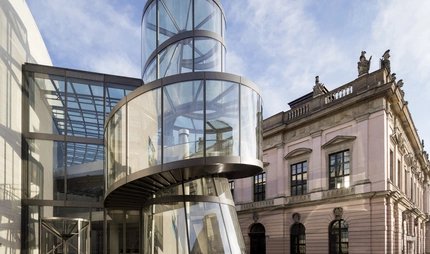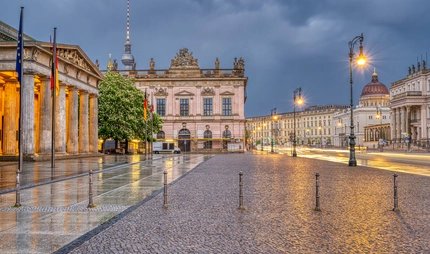
"Zeughaus"
A museum in an arsenal
The Zeughaus is one of the most important buildings in Berlin. It houses the Deutsches Historisches Museum. Find out all about the Zeughaus at visitBerlin.de.
The historic Zeughaus with its permanent exhibition is currently closed for comprehensive renovation. The modern exhibition hall, the Pei Building, remains open and continues to present exciting temporary exhibitions and events.
What was once an arsenal for weapons is now a museum. The oldest preserved building on the boulevard Unter den Linden is the city’s most important large Baroque building. Today, the pale pink building houses the Deutsches Historisches Museum (DHM) and gives you an insight into 1500 years of German history.
The history of the Zeughaus
The construction of the Zeughaus ran into problems right from the start. In 1667, Elector Friedrich Wilhelm of Brandenburg proclaimed in his will that a building for the military be constructed, but a lack of funds in cash-struck Prussia prevented this at first. Not until 1695 did Elector Friedrich III start building the arsenal – an armoury – naturally inspired by the Sun King’s magnificent Versailles.
The first chief architect was Johann Arnold Nering, who built the palace in Charlottenburg. When he died, Martin Grünberg took over the construction and Andreas Schlüter assumed overall responsibility. The building work took years, with lack of money, changing architects and poor building materials constantly delaying its completion.
In 1875 the arsenal was converted into a “pantheon to the glory of the Prussian army”, a war and weapons museum. After severe wartime damage, the interior of the building was completely redesigned during the restoration between 1949 and 1965. In 1952, the Zeughaus became the Museum for Deutsche Geschichte, and was renamed the Deutsches Historisches Museum in 1990. After extensive restoration, since 2006 it has housed the permanent exhibition German History in Images and Artefacts.
The architecture: Baroque pomp and classical simplicity
The building has four wings, each 90 metres long, surrounding an inner courtyard (Schlüterhof). Its overall appearance is characterised by the harmony between the strict, Neoclassical façade segmentation and the richly decorated Baroque relief sculptures. Your eyes are drawn to the twelve large groups of figures on the roof.
The courtyard
The courtyard holds a surprise – in a building dedicated to the art of war hang the 22 “Heads of Dying Warriors” by Andreas Schlüter. Faces distorted by pain and suffering show a different, more truthful representation of war than the victorious gods of war. The Elector approved it anyway – probably because they were supposed to be the heads of enemies.
The extension
In May 2003, the extension opened, designed by the Chinese-American star architect I.M. Pei, who had already designed the pyramid for the Louvre. The elegant sandstone and glass building fits in harmoniously with the surrounding historic buildings and it houses the temporary exhibitions of the Deutsches Historisches Museum.
Zeughauskino
The east wing of the building contains the Zeughauskino. The arthouse cinema, which was renovated in 2004, shows series of films on cinema history – which often include less known films that are worth discovering. Why not take a look?
Café im Zeughaus
Next to the cinema there is a pleasant café to relax in between visiting the museum and strolling down the boulevard Unter den Linden.
Art market at the Zeughaus
Every Saturday and Sunday on the east side of the Zeughaus, you can wander through a market with art and crafts. The stalls with their exquisite displays are very popular with Berliners.
Nearby attractions
- Museum Island
- Berlin Cathedral and Lustgarten
- Unter den Linden
- Berliner Schloss
- Maxim Gorki Theater
- Neue Wache
- Humboldt University
- Bebelplatz



